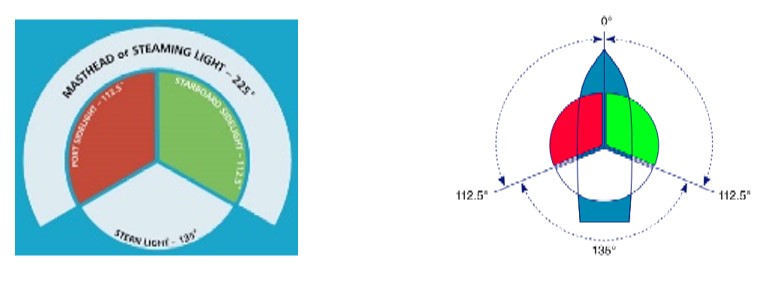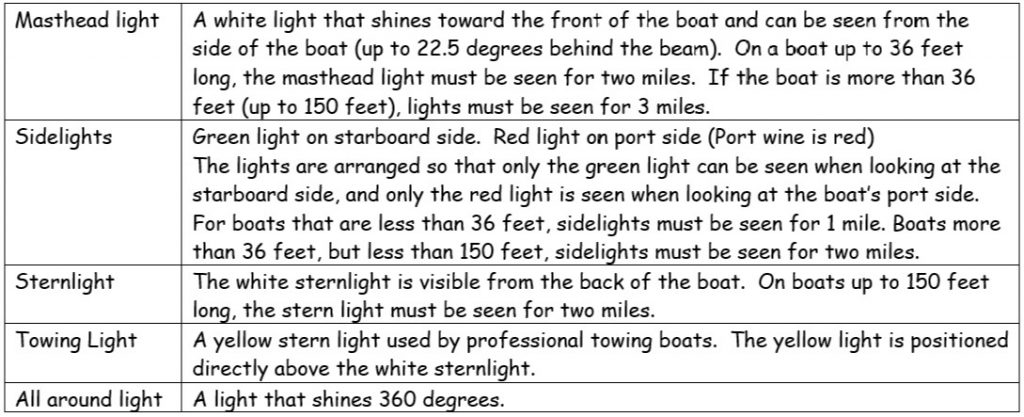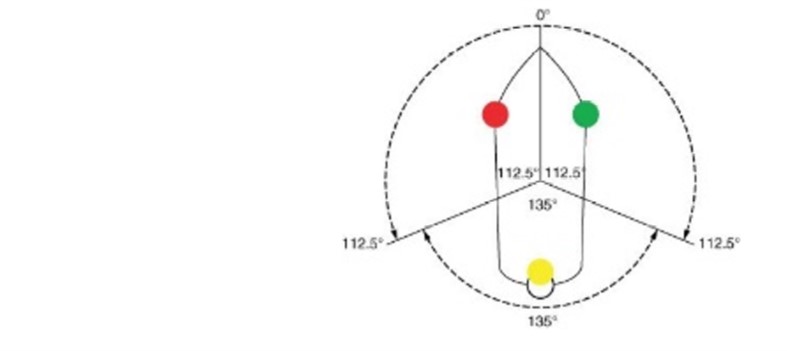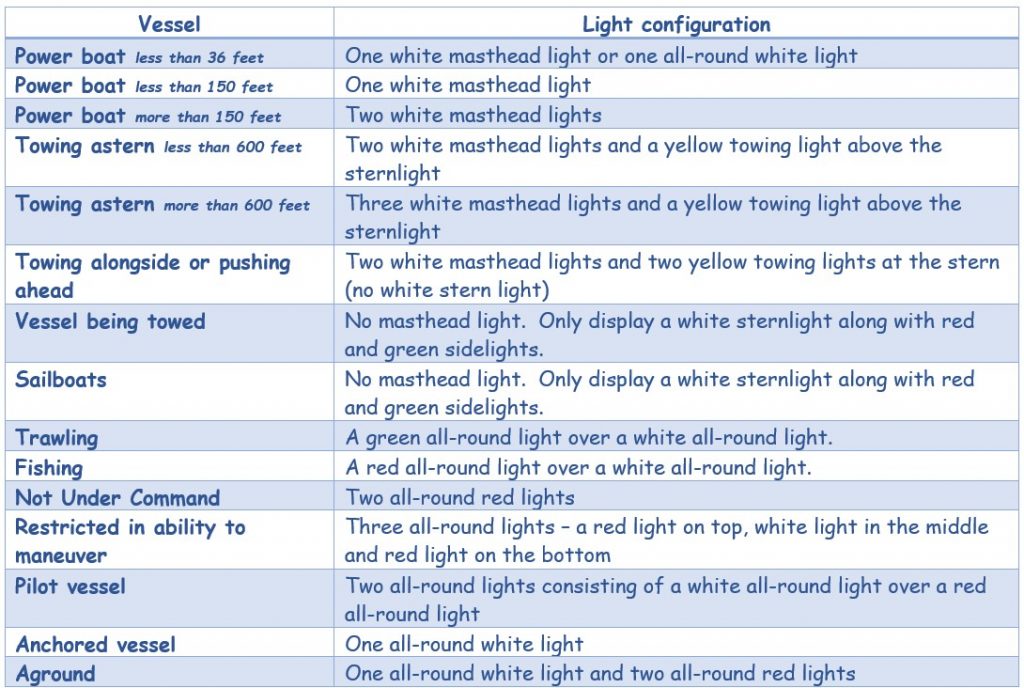Inland Navigation Rules
Nav Rules Make Easy
Rules 20 to 30
In the Nav Rules Made Easy series, we’ll explain each Inland Navigation Rule, with an emphasis on the information that’s most important for recreational sailing in the San Francisco Bay. We won’t include portions of the rules that are highly technical and intended for commercial mariners.
Note: If you travel more than one mile outside the Golden Gate Bridge or if you charter a boat in another country, the International Rules apply. Many of the International Rules are exactly the same as the Inland Rules. However, there are also a few that contain important and significant differences from Inland. Make sure that you study and learn International Rules if you are traveling in international waters.
This is just a simplified summary of the rules. To get detailed information, please refer to the Navigation Rules and Regulations Handbook from Department of Homeland Security, United States Coast Guard.
Rule 20 – Lights and Shapes — Application
Rules 20 to 30 provide guidelines and information about navigation lights and shapes. To put this whole section into perspective, think about driving on the freeway at night. If you see a lot of red lights in front of you, you know that you’re coming up on traffic that is going the same direction you are traveling. Cars have red lights at the back of the vehicle. If you see white whites, however, you know that the cars are coming toward you. Navigation lights for boats are more complicated than the light systems used traveling on roads.
All vessels must display proper navigation lights from sunset to sunrise and during periods of restricted visibility.
If there are any lights on the boat in addition to navigation lights, the other lights have to be arranged so that they cannot be mistaken for navigation lights. It’s also important that no lights interfere with keeping a proper lookout.
Rules 21 and 22 – Definitions and Visibility of lights
During the day, it’s fairly easy to see what kind of boat is out on the water. At night, however, it’s difficult. So, the navigation rules specify different lights for each type of vessel. That way you can tell the type of vessel by understanding the light pattern displayed.
Since we don’t operate Tradewinds boats at night, you might wonder why you should learn about navigation lights. There are a couple of reasons. First, you must use navigation lights in “reduced visibility” or fog. Second, you may decide to charter a boat and find yourself on the water at night. Of course, there’s also always the possibility that you go sailing on a friend’s boat after dark. When you’re out on the water at night, you want to be able to understand what you are seeing.
Before learning the “identity lights”, it’s important to understand a few terms:
Look at these diagrams to see the “masthead” light, sidelights, and sternlight:

This diagram shows the yellow “towing” light above the sternlight:
Rules 23, 24, 25, 26, 27, 29, 30 – Power-driven vessels underway
(There is no Inland Rule 28)
For this section, we won’t cover all of the technical details regarding specific lighting for towing and other special situations. To get more specific information about various tow configurations, please consult the Navigation Rules and Regulations Handbook.
All boats underway must have sidelights and a white sternlight. For all boats , the starboard sidelight is green and the port sidelight is red.
, the starboard sidelight is green and the port sidelight is red.
Boats differ in the color and configuration of the masthead or all-round lights displayed. When multiple “all-round” lights are shown, they are arranged in a vertical line.
When a boat is not underway (not making way through the water), the sidelights and sternlight are no longer displayed. This is the case when a boat is anchored or has run aground.
During the daytime, there are specific “dayshapes” that certain vessels are required to display.






OK, this is one of my pet peeves. What is more important than knowing the lights, for example for a pilot vessel, is understanding that you are not showing these lights just to satisfy some rule. Many sailors, otherwise competent, are individualists who don’t favor being told what to do. Your own safety and that of your crew is at stake, not your obedience.
A few years back I attended a traditional nautical service for the deaths of those crew who perished in the Low Speed Chase wreck at the Farallones. It was held off of the San Francisco Yacht Club in Tiburon at sundown, and attended by many sailboats whose skippers and crew must be considered to be among the more active sailors on the bay. After the service, which was very moving, people headed back to their respective harbors and turned on their lights to navigate in the dark. Only about half were showing the correct lights!!
The system of navigation lights on boats is the result of the consideration of thousands of incidents at sea, with a view towards their prevention. With lights, at a glance you can tell what type of vessel you’re seeing and its course. These together tell you whether you are the give-way or stand-on vessel. Some people think it’s smart to turn on everything. Others think that, to save their battery or to extend the life of a light bulb, it’s smart to run only the anchor light. Imagine what a busy captain of a merchant vessel or ferry thinks when he sees a white light. Do you think it’s wise to present him with a puzzle??
I found an old sidelight with red & blue lenses, why blue and not green? It looks like it’s from the 1950’s. It’s considerably larger than the side light on my 19’ rec. boat. Can I use this light on my boat?
Blue lights are reserved specifically for law enforcement I think. The rules are pretty clear about green, red, white being the navigation lights on your vessel.
It is pretty important to use the standard colors if you are interested in living, but have you taken a color blindness test? I arrived home with a new blue jumper to be told by my wife that it is green. I reported an incident where I was hit by a silver grey car only to be told by the cops that the car was metallic green. I know what I saw, only it isn’t what other people see. I was tested for color perception in the military and they didn’t report a problem. I’m also unable to accurately recall the color of objects.